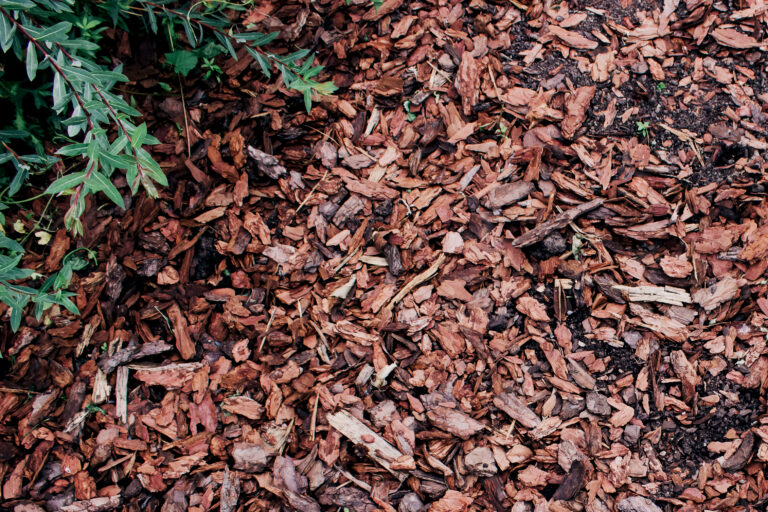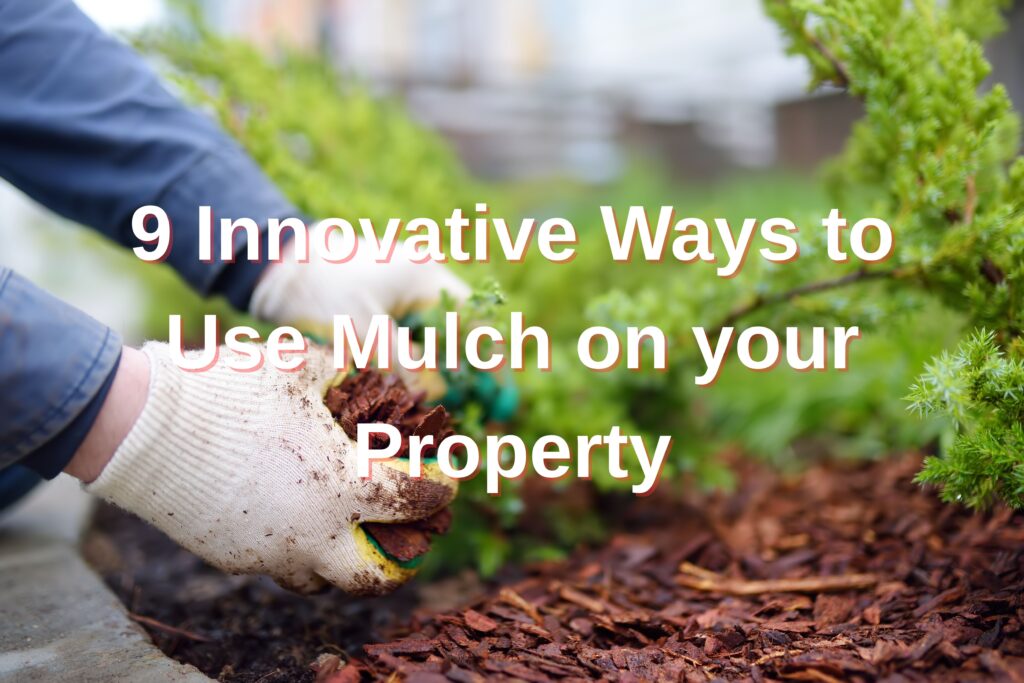Table of Contents
1. Define Beautiful and Functional Garden Pathways
Mulch can be used to create attractive garden paths that guide visitors through your yard while maintaining a natural, organic look. Unlike hardscaping, mulch paths are soft underfoot, affordable to install, and easy to maintain.
Benefits:
Natural look that blends with your garden
Good drainage and reduced mud after rain
Easy to refresh seasonally
Best mulch types for paths: Wood chips, bark nuggets, or cedar mulch.
Pro Tip: Add a landscape fabric base to prevent weeds and use edging to keep mulch in place. Want to dive deeper into weed prevention? Check out our blog: Laying Weed Barrier Underneath Mulch: Pros and Cons

2. Enhance Tree Rings
Mulch can turn ordinary tree bases into focal points. A neatly mulched tree ring not only looks polished but also supports the health of your trees by keeping roots cool, moist, and weed-free.
Design Ideas:
Try colored mulch to contrast with the tree bark.
Use natural stone or brick edging to give definition.
Add shade-tolerant perennials or ground covers inside the ring for layered beauty.
Caution: Avoid “volcano mulching”—piling mulch against the trunk. This can trap moisture and cause decay or invite pests.
3. Build a Safe and Stylish Mulch Play Area
If you have kids, mulch can be the perfect solution for a safe, clean play space. Playground-grade mulch is designed to absorb impact and reduce injuries from falls.
Why it works:
Non-toxic and soft underfoot
Drains well and reduces muddy messes
Budget-friendly alternative to rubber surfacing
Maintenance Tip: Add fresh mulch annually and rake it regularly to keep the surface even and cushioned.
4. Add Bold Color with Decorative Mulch
Colored mulch can significantly elevate the visual appeal of your property. Use black mulch to make bright flowers pop, red mulch to warm up cool-toned homes, or brown mulch for a natural, earthy feel.
Design Applications:
Highlight specific garden features like topiaries or statues.
Match mulch color to roof shingles or siding for harmony.
Create zones with different mulch colors for visual segmentation.
Sustainability Note: Choose mulch made with natural, non-toxic dyes that won’t harm your soil, pets, or plants.
5. Suppress Weeds Naturally
One of mulch’s best-known superpowers is weed suppression. A generous mulch layer deprives weeds of light, minimizing their ability to sprout while keeping the soil moist and healthy.
Advanced Tip: Combine organic mulch with a pre-emergent herbicide or cardboard base layer to further block persistent weeds. Want to choose the best mulch for your garden? Read our previous blog comparison: Organic vs Inorganic Mulch: What’s the Difference and Why it Matters to make an informed decision.
Mulch Types That Work Well:
Shredded bark
Straw (for vegetable beds)
Pine needles (ideal for acidic soil plants like azaleas and blueberries)
6. Design a Low-Water Xeriscape
Mulch plays a critical role in water-wise landscaping, especially in regions prone to drought. In xeriscaping, mulch is used to retain water, insulate roots, and slow evaporation around drought-tolerant plants.
Perfect Plant Pairings:
Lavender
Ornamental grasses
Sage
Agave
Material Suggestions:
Crushed bark or pine fines for a softer appearance.
Decomposed granite or pea gravel as a mulch alternative for high-drainage areas.
7. Use Mulch to Protect Vegetable Gardens
In the vegetable patch, mulch does double duty: it keeps weeds down and protects your produce. Organic mulch breaks down over time, improving soil fertility and encouraging beneficial earthworm activity.
Best Mulches for Edibles:
Straw: Clean and easy to work with.
Grass clippings: High in nitrogen (only use untreated clippings).
Compost: Dual-purpose mulch and soil amendment.
Pro Tip: Wait until the soil warms in spring before applying mulch in veggie beds to avoid slowing down plant growth.
8. Create Natural Borders and Edging
You don’t need bricks or steel edging to define your garden beds. A clean trench lined with mulch can act as an elegant and natural barrier that prevents grass encroachment and enhances your landscape’s organization.
Ideas for Implementation:
Outline curved flower beds with a deep mulch line.
Separate different zones (flower beds, pathways, trees) using varying mulch textures or colors.
Combine with boulders or driftwood for rustic border designs.

9. Cover Unsightly or Hard-to-Reach Areas
Have a corner of your yard that’s too shady or rocky to grow grass? Cover it with mulch instead! Mulch can easily hide patchy soil, construction debris, or awkward landscape transitions.
Creative Uses:
Fill gaps between stepping stones.
Mulch under decks or tree canopies.
Mulch around outdoor storage areas to reduce mud and mess.
Bonus Tip: Add garden ornaments, potted plants, or solar lighting on top of the mulch for an upgraded look.



